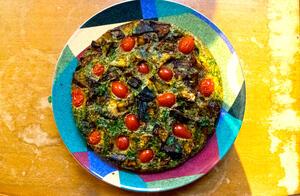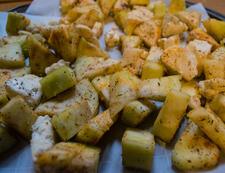Vegetarian Kuku for Passover
Chag Sameach everyone!
At my intensive yeshiva fellowship program, I learned a lot about Passover, namely that there were parts of the traditional seder that my family never does. We always lose interest as soon as the festive meal is served (sometimes even forgetting Elijah’s cup) and I recently learned that you’re supposed to do Hallel (songs of praise) at the end.
This year, I am using my year of learning to put together my family’s Haggadah for the first time. In the 45 minutes I’ve been allotted by my parents for the Haggadah reading, I am hoping to create an experience that is at once traditional, fresh, and thought-provoking. One of the challenges of the holiday is often sitting with the themes of Exodus, scriptural interpretation, and our own self-examination all at the same time.
Aside from the intellectual and spiritual challenges, Passover can also be nutritionally difficult as a vegetarian. With no chametz (levened grain), dietary options are limited. Many Ashkenazi people also do not eat kitniyot (“small things,” which includes beans, corn, legumes). I recently began eating kitniyot to hold off that particular type of Passover madness that finds you so hungry and frustrated with your limited food options that you cry uncontrollably during the last three days of the holiday.
And so, I offer a nutritious, delicious dinner recipe to stave off the Passover madness. It is easily made parve, so you can have it with your meat or dairy meals. It works great for large or small seder gatherings, and with vegetarians and meat-eaters alike.
Kuku is an Iranian/Persian egg dish that I would describe as frittata-like. It’s flavorful, nutritious, and can be as complicated or as simple as you want. While you cook, I would recommend watching The Prince of Egypt, or listening to the Girls in Trouble discography about women in Tanakh and Talmud.
Initially inspired by a recipe in Plenty More, now adapted.
Materials
8 inch cake pan
Ingredients
1 medium eggplant
1 head cauliflower, separated into small florets
3 heads garlic, cloves separated
1/2 yellow onion, diced
1/3 cup chopped Italian parsley
1/3 cup chopped cilantro
1/3 cup chopped oregano
5 eggs
1 teaspoon cumin
1/2 teaspoon paprika
1 teaspoon zaatar
1.5 teaspoons baking powder [note: if it is against your practice to use baking powder during Passover, it is fine to leave out]
salt, pepper to taste
1/2 cup cherry tomatoes
Directions
Preheat oven to 400° degrees.
Start by getting together your vegetable and herb filling! My current food obsession right now is eggplant so I’m using that, but feel free to use whatever works best for you.
Peel eggplant and chop up into cubes, about 1/2 to 1 square inches. Toss in olive oil, paprika, zaatar, salt, and pepper.
Dice onions.
Roast eggplant, onion, garlic (whole cloves), and cauliflower until tender (about 30 minutes).
Cut the end off the garlic gloves and scrape out soft inside to later mix into eggs.
After removing the vegetables, turn down the oven to 350°.
While your vegetables are roasting, finely chop parsley, oregano, and cilantro.
Whisk eggs with a fork or an actual whisk, getting them at least medium-fluffy.
Mix in baking powder, the chopped herbs and cumin. Whisk well. The eggs will look extremely colorful at this point which may make you feel weirdly productive and festive.
Pour the vegetables into the egg mixture and mix thoroughly to get consistent texture.
Oil either a cake pan or pie pan, or feel free to butter and flour if you’re not trying dairy-free.
Pour your vegetable and egg mixture into your pan, and drop tomatoes in whatever pattern is most aesthetically pleasing to you across the top. Put the pan in the oven, and cook at 350° for about 25 minutes, or until a toothpick comes out clean.
Let the kuku cool for at least 10 minutes before overturning or gently using a spatula remove it from the pan. Serve on your kosher-for-Passover dishes, and enjoy. I recommend eating alongside some spinach salad and matzah, if you still have the stomach for it.
I hope you all have a meaningful and fun holiday! As I write this, I am suddenly overwhelmed with the desire to start a fresh pasta empire, so look for that after Passover!










